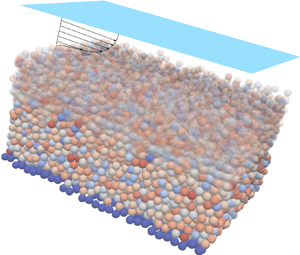Article contents
A frictional–collisional model for bedload transport based on kinetic theory of granular flows: discrete and continuum approaches
Published online by Cambridge University Press: 01 June 2023
Abstract

In this work, the modelling of collisional bedload transport is investigated with a focus on the continuum modelling of the granular flow. For this purpose, a frictional–collisional approach, combining a Coulomb model with the kinetic theory of granular flows, is developed. The methodology is based on a comparison with coupled fluid–discrete simulations that the classical kinetic theory model fails to reproduce. This inaccuracy may be explained by the assumptions of negligible interparticle friction and the absence of a saltation model in the continuum approach. In order to provide guidelines for the modelling, the fluctuating energy balance is computed in the discrete simulations and systematically compared with the kinetic theory laws. Interparticle friction is shown to affect the radial distribution function and to increase the energy dissipation, in agreement with previous observations. In addition, a saltation regime is identified, leading to departure from the viscosity and pseudo-thermal diffusivity laws of the kinetic theory in the dilute regime. Based on these observations, modifications to account for interparticle friction are included in the two-fluid model, and the kinetic theory is coupled with a saltation model. The results show that for inelastic frictional particles, interparticle friction controls energy dissipation, and the macroscopic behaviour of the granular flow does not depend on the microscopic particle properties. The proposed model reproduces the  $\mu (I)$ rheology in the dense regime of the granular flow. Finally, the model is evaluated with experiments, showing significant improvements concerning the granular flow modelling.
$\mu (I)$ rheology in the dense regime of the granular flow. Finally, the model is evaluated with experiments, showing significant improvements concerning the granular flow modelling.
- Type
- JFM Papers
- Information
- Copyright
- © The Author(s), 2023. Published by Cambridge University Press
References
- 9
- Cited by



